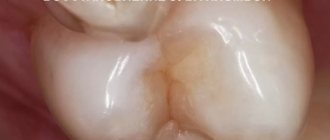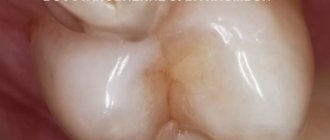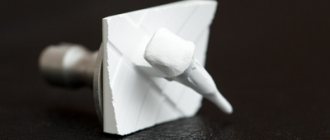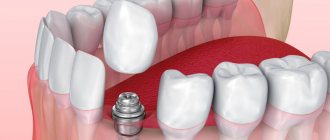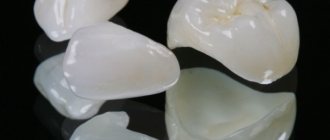January 12, 2018
If the crown or top of the tooth is too badly damaged and it is impossible to fix an artificial crown on it, some kind of support must be installed - this can be a metal pin or a stump inlay. Both of these prostheses are designed to strengthen the tooth root and create support for the crown, since part of them is located above the gum. But they have quite a lot of differences. UltraSmile.ru decided to figure out which of these prostheses is better for restoring a tooth.
Content
- Details about the pin
- Details about the tab
- Materials for production
- What the inlay and pin have in common
- Differences
- What to choose - pin or tab
Currently, dentists offer many options for prosthetics and dental treatment. Modern technologies can solve almost any problem. It is important to choose the best option for a particular case. If treatment of a decayed tooth is required, the choice is between an inlay and a pin.
PROMOTION
Dental restoration, installation of fillings
from 2200 rub.
Pros and cons of tabs
To decide which is better, a pin or an inlay, you need to evaluate the strengths and weaknesses of both types of designs. The advantages of tabs are:
- They can withstand high chewing loads and are securely fixed in the root canals.
- Easily replaceable in case of destruction.
- They allow you to restore teeth with curved and even impassable canals.
- Durability and structural strength.
- Possibility to serve as a support for fixed prosthetics (bridge).
Flaws:
- Long production time.
- Careful preparation of dental tissues and significant grinding.
- Long-term treatment: several visits to the dentist will be required.
Pin
This is a rod installed in the root of the tooth to strengthen it and ensure subsequent treatment. It is installed when there is severe destruction, when no more than half of the root remains. The materials used for manufacturing are polymers or metals. A serious disadvantage of metal pins is the need to greatly expand the root canal, as a result of which its strength decreases. Fiberglass pins do not have this drawback and are similar in characteristics to natural dentin.
When choosing a manufacturing material, we proceed from specific requirements:
- For prosthetics of the front teeth, fiberglass is used;
- Metal products are intended for chewing units with severe destruction;
- Carbon fiber is a universal option, suitable for any teeth.
There are two types of fastening:
- Passive – on dental cement, without load on the root;
- Active - the pin is screwed into the root using a thread.
Anchor pins
A great variety of anchor pins are used in dentistry:
- by material of manufacture: titanium, steel, brass, fiberglass;
- according to the method of fixation: active (with an active sharp thread, like a self-tapping screw), passive (smooth, stepped ribbed) and something in between (with a smooth blunt thread);
- in shape: cylindrical and conical (with different tapers);
- In addition, each manufacturer produces pins of its own original design in different sizes and claims that its pins fit all pins.
But such diversity does not confuse dentists. Anchor pins appeared on the Russian market quite a long time ago, and each of us already clearly understands the indications and contraindications for this or that type of pin. Anchor pins significantly expand the dentist’s capabilities and can be used both for tooth restoration using photopolymer material, and for restoring the “stump” of a tooth for a crown.
Tab
This is also a prosthetic design that imitates part of a tooth. Used for teeth located behind the canine teeth.
There are:
- Restorative inlays - to recreate the correct shape, bite and natural shade of the tooth;
- Stump inlays are placed under the crown and serve as the foundation for it.
The difference from the pin is in the device - the inlays consist of two parts - the pin itself and an element that replicates the tooth. The manufacturing process takes place under pressure at high temperatures. The root part is an attachment for the root and looks like a rod. The upper element follows the shape of a crown.
Prices for stump inlays
How much does a stump tab cost? Prices for stump inlays can vary greatly: the main influence on the cost of the structure will be exerted by the material of its manufacture. The most budget option is metal stump inlays. A simple non-removable (cast) metal stump inlay costs about 5,000 rubles. A collapsible multi-root metal stump inlay will cost a little more - from 6,000 rubles and more.
Ceramic and zirconium stump inlays have the highest prices. Their cost starts from 8,000 rubles.
IMPORTANT: The cost of making a core tab does not include the cost of installing a crown! Dental treatment, canal filling, production and installation of a crown are paid separately!
Material of manufacture
A variety of materials can be used, including:
- Metals and composites are the most popular option, they are easy to manufacture, durable and have an affordable price;
- Ceramic - similar to natural tooth enamel, the most aesthetic option;
- Zirconium - combines the best qualities of the previous options - they are aesthetically pleasing and durable, but are not very popular because they are very expensive.
When to choose stump inlays
It happens that the top of the tooth is severely destroyed, but a significant part of its hard tissue is preserved. In such a situation, the dentist can use filling material to restore the missing tooth part. However, to securely install a crown in such a tooth, special fastening structures are required to prevent it from further deteriorating. In this case, the doctor forms a stump prosthesis in the crown area.
In situations of destruction of the coronal part of the tooth or thinning of its walls, the use of a stump inlay is undesirable. Otherwise, the root after such prosthetics will not cope with the chewing load and will crack. Then the tooth cannot be restored.
However, with a skillful doctor and adequate indications, the stump tab is a guarantee that the root will be well strengthened and “withstand” the chewing load. At the same time, the tooth itself will be completely preserved, since the extremely strong cement connection will ensure a perfectly tight fit of the core structure to the dental residue, saving it from splitting.
Differences
- The pin puts pressure on the root of the tooth, which can cause it to become loose; there is pressure on adjacent teeth, and the inlay eliminates this load.
- Time of use - the pin can be used for up to 3 years, the inlay - much longer, almost 10 years.
- The pin is a single design, but the tab can separate.
- It is not difficult to make a pin, but to make an inlay, laboratory specialists are involved and special studies are carried out.
- The installation of the pin is carried out in one visit to the dentist; to install the inlay, you will have to visit the doctor at least twice.
- If the tooth has a crooked root, you can only use an inlay.
- The cost of an inlay is significantly higher than a pin.
- Preparing the tooth for the installation of a pin is relatively gentle; in order to install the inlay, a large amount of tissue is removed.
The difference between a pin and an inlay during tooth restoration
What is the difference between a pin and an inlay?
Only a doctor can make the right choice, guided by the degree of tooth destruction and the possibility of using one of these types of restoration. Both methods have their advantages and disadvantages; only an experienced dentist at Dr. Grossmann German Dentistry has all the necessary information to make the right choice.
Advantages of pins in tooth restoration.
If we are talking about restoring a tooth using a pin, then strong cleaning of the tooth is not required, since the pin is much thinner than the inlay, which ensures its popularity in dental practice. Also, the cost of treatment using a pin is usually lower than using an inlay. In addition, this technique reduces treatment time down to 1 visit to the dentist’s office. This method is most popular among patients.
Disadvantages of dental restoration using pins.
When treating a tooth using a pin, there is no connection between it and the tooth crown itself, therefore, under heavy chewing loads, the crown may fall off; Also, if the material from which the pin is made is incorrectly selected, the tooth may place excessive load on the jaw bone, which will lead to deformation of the tooth root and its destruction. This can lead to inflammation at the root. To avoid such troubles, it is necessary to perform dental treatment only in elite dentistry, where doctors have the necessary experience, knowledge and use only high-quality materials. German dentistry of Dr. Grossmann meets all the requirements of high-quality elite dentistry in Moscow.
Benefits of restoring teeth using inlays.
The inlay is a one-piece structure that consists of the roots and the crown itself, so the service life of such an artificial tooth increases. In addition, very durable metal alloys are used in the manufacture of the inlay, which makes the restoration the most reliable. The load during chewing is distributed evenly on the bone along the tooth shaft, as well as the root and crown of the tooth, which allows you not to overload the jaw bone tissue and increase the service life of the inlay.
Disadvantages of tabs.
As a rule, such dental treatment does not occur in one visit to the dentist; prosthetics can last two or three sessions; the fact is that the dental inlay is made in a dental laboratory using individual impressions. Also, to install such a structure, more tooth preparation is required, and this is not possible in every case, but still, this is an excellent alternative to installing an implant if the patient has preserved the root of the tooth. Of course, if we are talking about the differences between a pin and an inlay, it is necessary to take into account all the features of such a restoration, as well as the duration of the procedure. The price of prosthetics using an inlay is usually more expensive, but despite its disadvantages, this technique is the most reliable and durable.
From metal to composite
What is a core inlay for a crown, if not a pin structure? Yes, indeed, the root part of this device resembles a pin, but they have radical differences. The pin is placed exclusively under the filling. The stump inlay for the crown is inserted into the tooth root, may have several pins and should not be covered with a filling.
The orthopedic design imitates the missing canal space; it is made according to individual measurements. Its upper part copies a tooth ground for a crown. Thus, the load during chewing food is distributed evenly.
There are the following types of tabs:
- Metal - made of silver, gold, cobalt or chrome. Very reliable, but not aesthetically pleasing.
- Metal-ceramic ones are the least strong of all the inlays, which is due to the difference in thermal expansion of the two materials.
- Ceramic - an aesthetic option, they copy natural tooth enamel.
- Zirconium inlays are highly durable and look as natural as possible.
- Composite - they adhere to the tooth tissue better than others, but are not very durable.
Interesting fact! Dentists call zirconium “white gold.” Thanks to its color and structure, it imitates tooth enamel better than other materials.
Considering the question of how tooth inlays are made under a crown, it should be noted that core inlays made of zirconium dioxide and ceramics are made using computer modeling.
The remaining tabs are made in 2 ways:
- Indirect: after taking an impression of the canals, a dental laboratory first makes a plaster, then a wax, and finally a metal model.
- Direct: the sanitized tooth is filled with heated plastic using a syringe, an inlay is formed, which is sent to the laboratory to create a microprosthesis.
Tabs are used not only to act as a support. They also correct incorrect position and shape of teeth, and eliminate defects in the supragingival area.
